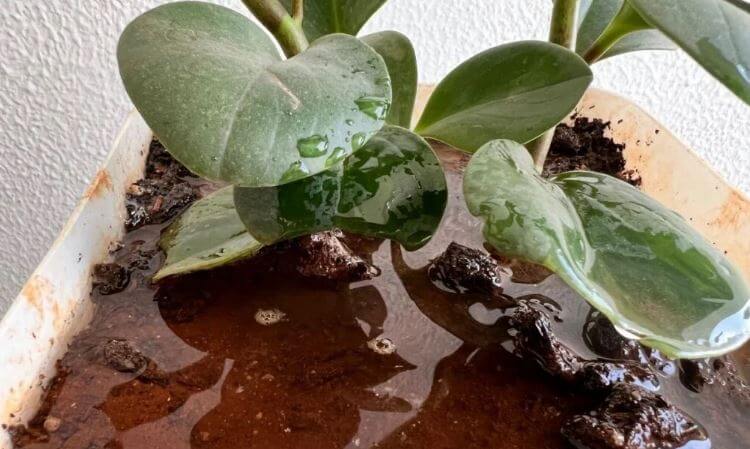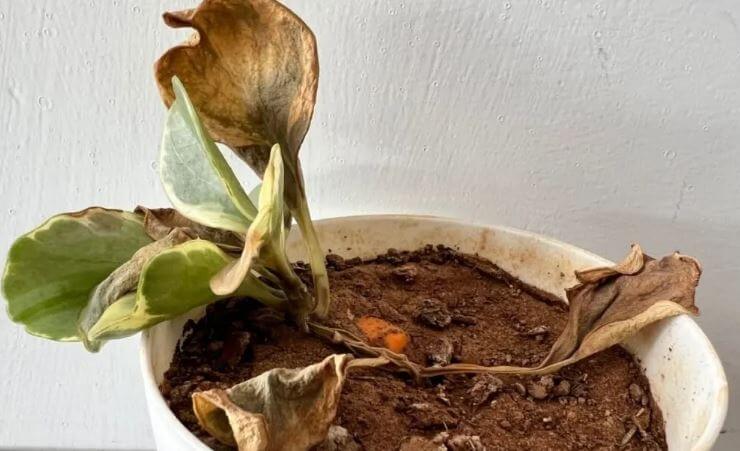Last Updated on June 27, 2023 by a Friendly Gardener
The lovely Peperomia is a delightful houseplant that does not ask much of its owner. Often called a Radiator plant, a common problem for this plant is root rot. This decaying infection will destroy the plant’s root system and is usually the result of soggy soil.
An increasingly popular variety is watermelon peperomia which is small and ideal as a houseplant. It boasts leaves that resemble the rinds of watermelon. Watermelon peperomia root rot is just as common as root rot in other peperomia varieties and requires the same care to keep it healthy.
The unfortunate thing about root rot is that initially there may be no indications above the soil surface. Once symptoms appear, damage to the root ball is generally severe.
What Is Root Rot?

Root rot is an illness that attacks the root systems of plants and trees. It causes root systems to decay and when left untreated, will cause the death of the plant.
What Causes of Root Rot in Peperomia Plants?
Generally, root rot is caused by overwatering or because of a soil bed that drains poorly. Water-laden soil will prevent the root system from absorbing much-needed oxygen. The soil bed becomes hypoxic meaning it has a very low oxygen level. The root system will slowly be starved of oxygen with roots decaying and your Peperomia dying.
There are several other causes of root rot. Among the causes we find:
- Acquisition of a plant that is already ill
- Contaminated gardening tools
- Contaminated soil
- Improper environmental temperature
- Improper containers
- Improper soil
- Infection pathogens
- Lack of drainage
- Lack of air ventilation
- Overfeeding
- Overwatering
- Plant stress
Acquisition of a plant that is already ill
Sometimes, one gets unlucky and buys a plant that is already infected. It’s important to use a reputable garden center or nursery when acquiring new plants to cultivate. When selecting plants, look for specimens that have glossy healthy-looking foliage without spots or holes. When you bring a new Peperomia home, keep it isolated for several days in case it is infected to prevent spreading to other plants.
Contaminated gardening tools
If you have more than one plant that you are cultivating whether indoors or outdoors, you need to sterilize your tools after use with individual plants. This helps to prevent the spreading of infections and parasites among them.
Contaminated soil

Avoid using old soil or that from your outdoor garden. These soils may harbor bacterium, fungi, or parasites that you are unaware of. Use good-quality potting soil from a trusted nursery or gardening center.
Improper environmental temperature
Environmental temperature is important for any houseplant, not only because it mimics the natural habitat but plays an important role in moisture evaporation. The Peperomia likes its location to have a temperature measuring between 55° and 75°F. Lower temps can slow growth and help to propagate pathogens.
Improper containers
A Peperomia will do best when planted in a clay, terracotta, or porous container that aids in wicking away excess moisture in the soil bed. Porous pots also aid soil aeration. Glass or plastic pots will prevent evaporation and contribute to soil becoming soggy.
Improper soil

The Peperomia has by nature a small root system. In their native habitat, you will find them in tree nooks where roots attach to decaying tree bark. This plant needs loose, chunky, porous soil that facilitates aeration and drainage. Heavy soils or clay-based soils will tend to retain water, allowing them to become soggy quickly. Consequently, aeration will suffer impeding oxygen flow to the roots.
Infection pathogens
Peperomia plants are susceptible to some pathogens and in particular to Phytophthora parasitica and Pythium splendens.
Phytophthora parasitica may arrive with cuttings from other plants. The infection begins in the root system and quickly spreads throughout the entire plant. Contaminated water can also be a cause.
Pythium splendens will cause severe root decay with roots and plants slowly turning black and becoming mushy.
Lack of drainage

Perhaps you are not overwatering, but your plant is showing signs of root rot. The problem may not be the amount of water but a lack of drainage. The container you choose needs an ample number of drainage holes and you should check occasionally to make sure the pot is draining after watering.
Lack of air ventilation
Appropriate airflow is vital to the health of houseplants and helps with humidity levels. Airflow aids evaporation and can contribute to more oxygen density in soil beds. Put your Peperomia in a location with good air ventilation.
Overfeeding
Excessive fertilization can damage your plant. Overfeeding will stress the peperomia and can impede the plant from absorbing nutrients from the soil as it can lead to excessive salt buildup in the soil bed.
Overwatering
This is probably the number one cause of root rot in plants and trees. Peperomia is an epiphytic tropical plant, so it requires little water to survive. For peperomia, you must check moisture in the soil bed before watering. If the topsoil is still damp, wait to water your plant. Excess water will impede oxygen from reaching the root system. Overwatered Peperomia can lead to infection without the plant having any apparent symptoms.
Plant stress
Peperomia is generally a stress-free plant and very adaptable to its settings. They will survive a bit of neglect but not excessive care as in watering or feeding.
Peperomia Root Rot Symptoms

Root rot is fatal if left untreated. Unfortunately, identifying root rot is not always an easy task. There are some symptoms however that should grab your attention.
- Your peperomia is declining. Shrinking, pale leaves can be a clue that your plant has root rot.
- Brown, yellow, or wilting foliage
- Mushy, black roots perhaps emanating a foul smell
How to Fix Peperomia Root Rot
The first thing to do is check the health of the plant’s root system. You will need to remove the plant from the soil bed and check the condition of the roots. If the entire root ball is already black and mushy, you are too late. If a portion of the roots is still whitish in color and firm in texture, you may be able to save it.
- Examine root system conditions
- Wash the root ball in tepid water
- If there are healthy sections, use sterilized tools to cut away all infected portions
- Prune some of the foliage. This is necessary because it will place less of a strain on the root system that has been trimmed and reduced in size. Don not, however, prune too many leaves as this will impede photosynthesis which is how the plant gets its nourishment.
- Change the pot or sterilize it thoroughly before reusing it. You can eliminate fungi and bacteria with a diluted bleach solution that uses 4 parts water to 1 part bleach.
- Dip the newly trimmed roots in a fungicide such as Neem oil.
- Repot your peperomia plant in fresh loose soil and a container with drainage holes.
Peperomia Plant care Tips
- Maintain room temperature between 55° and 75°F.
- Position it in indirect light.
- Water only when the top of the soil bed is dry.
- Use a space humidifier or pebble tray to maintain humidity levels between 40% and 60%.
- Use organic fertilizer to feed.
- Observe your plant for new growth or signs of re-infection.
What About Underwatered Peperomia?
Underwatered peperomia will not cause root rot. The soil will become hard, and your plant’s leaves will begin drooping. Eventually, the entire plant will wilt. If you have underwatered your Peperomia, soak your plant from the bottom for approximately 45 minutes. This will permit the soil to absorb the amount of water it needs.


